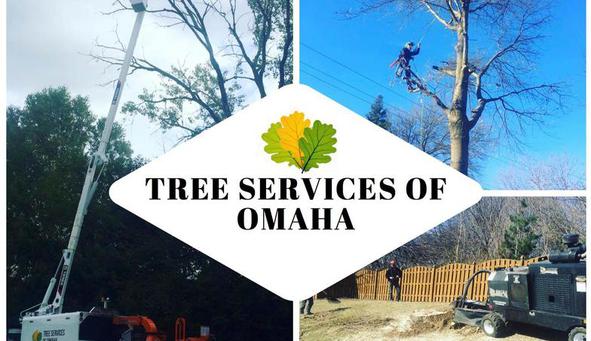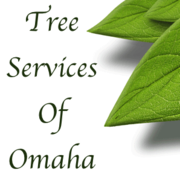Tree Services of Omaha - Omaha, Nebraska
Fruit Trees - Pruning & Training
by David Steg on 10/01/14
Growers often neglect the annual training and
pruning of fruit trees. Without training and pruning, however, fruit
trees will not develop proper shape and form. Properly trained and
pruned trees will yield high quality fruit much earlier in their lives
and live significantly longer.
A primary objective of
training and pruning is to develop a strong tree framework that will
support fruit production. Improperly trained fruit trees generally have
very upright branch angles, which result in serious limb breakage under a
heavy fruit load. This significantly reduces the productivity of the
tree and may greatly reduce tree life. Another goal of annual training
and pruning is to remove dead, diseased, or broken limbs.
Proper tree
training also opens up the tree canopy to maximize light penetration.
For most deciduous tree fruit, flower buds for the current season's crop
are formed the previous summer. Light penetration is essential for
flower bud development and optimal fruit set, flavor, and quality.
Although a mature tree may be growing in full sun, a very dense canopy
may not allow enough light to reach 12 to 18 inches inside the canopy.
Opening the tree canopy also permits adequate air movement through the
tree, which promotes rapid drying to minimize disease infection and
allows thorough pesticide penetration. Additionally, a wellshaped fruit
tree is aesthetically pleasing, whether in a landscaped yard, garden, or
commercial orchard.
Historically, fruit tree form and structure have been maintained by pruning. Tree training, however, is a much more efficient and desirable way to develop form and structure.
Pruning is the removal of a portion of a tree to correct or maintain tree structure. Training is a relatively new practice in which tree growth is directed into a desired shape and form. Training young fruit trees is essential for proper tree development. It is better to direct tree growth with training than to correct it with pruning.
Pruning is most often done during the winter, commonly referred to as dormant pruning. Training includes summer training and summer pruning as well as dormant pruning. The goal of tree training is to direct tree growth and minimize cutting.
Trees respond very differently to dormant and summer pruning. Dormant pruning is an invigorating process. During the fall, energy is stored primarily in the trunk and root system to support the top portion of the tree. If a large portion of the tree is removed during the winter, while the tree is dormant, the tree's energy reserve is unchanged. In the spring, the tree responds by producing many new vigorous, upright shoots, called water sprouts, which shade the tree and inhibit proper development. Heavy dormant pruning also promotes excessive vegetative vigor, which uses much of the tree's energy, leaving little for fruit growth and development.
Historically, much of the vigorous, upright vegetative growth has been removed during the dormant season; heavy dormant pruning results in a yearly cycle with excessive vegetative growth and little or no fruit production.
Timing of dormant pruning is critical. Pruning should begin as late in the winter as possible to avoid winter injury. Apple and pecan trees should be pruned first, followed by cherry, peach, and plum trees. A good rule to follow is to prune the latest blooming trees first and the earliest blooming last. Another factor to consider is tree age. Within a particular fruit type, the oldest trees should be pruned first. Younger trees are more prone to winter injury from early pruning.
Summer pruning eliminates an energy or foodproducing portion of the tree and results in reduced tree growth. Pruning can begin as soon as the buds start to grow, but it is generally started after vegetative growth is several inches long. For most purposes, summer pruning should be limited to removing the upright and vigorous current season's growth; only thinning cuts should be used. To minimize the potential for winter injury, summer pruning should not be done after the end of July.
Thinning Cut - removes an entire shoot back to a side shoot. Thinning cuts do not invigorate the tree in comparison to some of the other pruning cuts.
Heading Cut - removes only the terminal portion of a shoot. This type of cut promotes the growth of lower buds as well as several terminal buds below the cut. When lateral branches are headed into oneyearold wood, the area near the cut is invigorated. The headed branch is much stronger and rigid, resulting in lateral secondary branching. Older trees can be held in their allotted space by mold and hold cuts, which are devigorating heading cuts made into twoyearold wood. Young trees and branches where heading cuts are made will be referred to as headed.
Bench Cut - removes vigorous, upright shoots back to side branches that are relatively flat and outward growing. Bench cuts are used to open up the center of the tree and spread the branches outward. This is a major cut and should only be used when necessary.
When making pruning cuts, it is important to use techniques that will allow the cut surface to heal quickly. Rapid healing minimizes the incidence of disease and insect infection. Pruning cuts should be flush with the adjacent branch without leaving stubs. Also, when large horizontal cuts are made, they should be slightly angled so that water does not set on the cut surface, allowing the growth of rot and disease organisms.
Many compounds are available as wound dressing or pruning paints. But the best treatment is to make proper pruning cuts and allow the tree to heal naturally. If preferred, tree paints and wound dressing may be used for aesthetic reasons, but they will not promote healing.
One of the most frequently asked questions is, "To what shape should I train my fruit tree?"
It is difficult to give one answer. You can choose from many different training shapes and forms with multiple variations on each form. This bulletin focuses primarily on the central leader and open center training systems for mediumdensity orchards. A list of fruit trees conventionally trained to each system is also included. A fruit tree may be trained to any system. Depending on the form and function of the desired shape, you may want to train a tree to a nontraditional system.
Whatever system is chosen, keep in mind that the objectives of training and pruning are to achieve maximum tree life and productivity.
A central leader tree is characterized by one main, upright trunk, referred to as the leader. Branching generally begins on the leader 24 to 36 inches above the soil surface to allow movement under the tree. The first year, 3 to 4 branches, collectively called a scaffold whorl, are selected. The selected scaffolds should be uniformly spaced around the trunk, not directly across from or above one another. Above the first scaffold whorl, leave an area of approximately 18 to 24 inches without any branches to allow light into the center of the tree. This light slot is followed with another whorl of scaffolds. Alternating scaffold whorls and light slots are maintained up the leader to the desired maximum tree height.
The shape of a properly trained central leader tree is like that of a Christmas tree. The lowest scaffold whorl branches will be the longest and the higher scaffold whorl branches will be progressively shorter to allow maximum light penetration into the entire tree.



